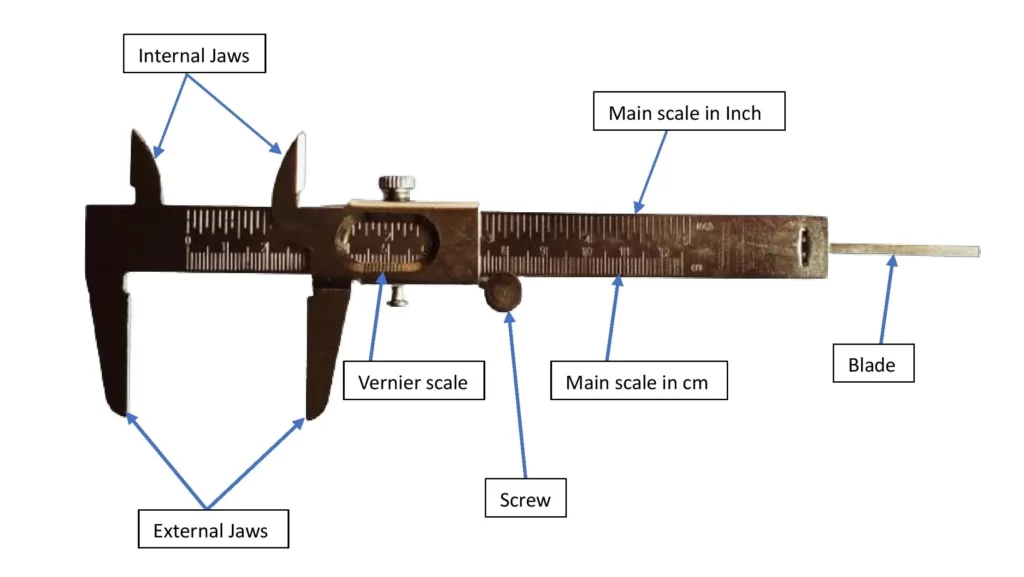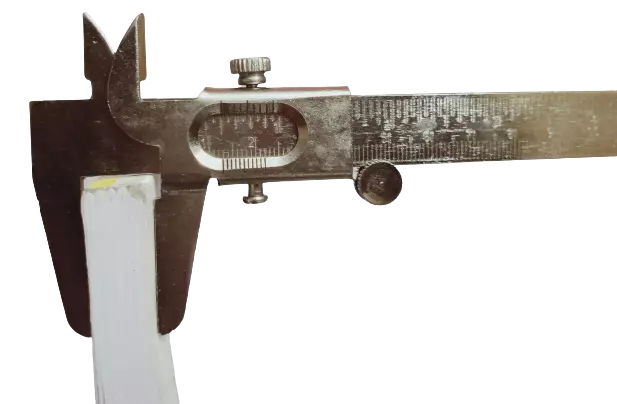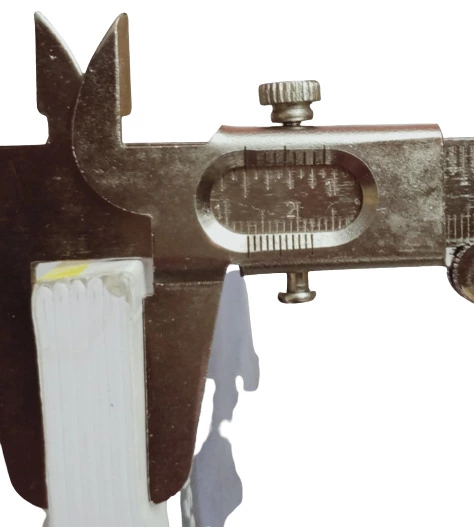Suppose you need to measure the length of a notebook. What will you do? I guess, you will measure it with your ruler scale. That’s fine because you don’t have to consider the error here. But if you are asked to measure the thickness of a thin rectangular plate, then which instrument will you use? In this case, a regular scale cannot be used. Because while measuring a smaller value, a little error appears to be a large error. In this case, a vernier caliper or slide caliper is to be used. In this article, I’m going to explore vernier calipers in detail with their diagram, principle, readings and use.
What are Vernier Calipers?
Vernier calipers or Slide calipers are measuring instruments that can measure small lengths with much more accuracy than normal scales. A vernier caliper consists of two scales – a main scale and a vernier scale.
The main scale is the same as a normal centimeter scale and the vernier scale is introduced so that the measurement of the combined system becomes much more accurate.
What to measure with a Vernier Caliper?
A vernier caliper can measure the followings –
- Thickness of a small plate like a rectangular plate.
- External diameter of a beaker.
- Internal diameter of a beaker.
- Depth of a beaker.
Diagram of Vernier Calipers
I’ve got a Slide caliper in my hand. The diagram of this caliper is shown in Figure – 1.

Parts of the vernier caliper are labeled in the image. There are two types of main scale – one can measure in cm and the other can measure in inches. The functions of other parts are given below.
Functions of different parts of a Vernier Caliper
Main Scale
The main scale can measure the length in either cm or inch. The smallest division of the main scale in Figure – 1 is 1 mm or 0.1 cm as the 1 cm is divided into 10 divisions. This scale can measure a maximum of 12.5 cm or 5 inches. In other vernier calipers, this smallest division can be different like 0.5 mm, etc and the maximum scaling can also be different.
Vernier Scale
The vernier scale can increase the accuracy of the measurement. The smallest division of the vernier scale is \small\frac{9}{10} of the smallest main scale division as the 10 divisions of the vernier scale match 9 divisions of the main scale. That means 0.9 mm is the smallest division of the vernier scale.
External Jaws
The external diameter of a beaker, thickness of a parallelepiped, diameter of a ping-pong ball, etc. can be measured by inserting those between the two external jaws.
Internal Jaws
The internal diameter of a beaker and a hollow sphere can be measured with the help of internal jaws.
Blade
The blade of the vernier caliper can be used to measure the depth of a beaker. Its length can be adjusted by scrolling the screw toward the right or left.
How to read Vernier Caliper readings?
Suppose we need to measure the thickness of a notebook. Going through the following steps one can understand the practical use of a vernier caliper.
Step – 1: Find the Least Count of vernier calipers
- Observe the 1 smallest division of the main scale. In our case, it is 1 mm.
- Then match the zero of the vernier scale to the zero of the main scale carefully.
- Observe what divisions of vernier scale match what divisions of main scale. In our caliper, 10 vernier divisions match 9 main scale divisions.
- This indicates that 1 vernier division equals to \small\frac{9}{10} of 1 main scale division. That means the 1 smallest vernier division is \small\frac{9}{10} mm as the 1 main scale division is 1 mm.
The Least Count of the vernier caliper = (1 smallest division of mains scale – 1 smallest division of vernier scale)
or, \small L.C. = (1 - \frac{9}{10}) mm
or, \small L.C. = \frac{1}{10} mm = 0.1 mm = 0.01 cm
Thus the combination of the main scale and vernier scale can measure as minimum as 0.01 cm. This is what the least count or the vernier constant of the vernier calipers.
Step – 2: Insert the notebook’s thickness between the external jaws
Insert the notebook between the two external jaws tightly as shown in Figure – 2. The screw will help to move the jaws forward and backward.

Step – 3: Observe the readings of Vernier Caliper

- Check what main scale reading has the zero of vernier crossed. This indicates the main scale reading (MSR). In our case, MSR = 1.2 cm.
- Observe which division line of vernier matched any of the division lines of the main scale. This gives the reading for the vernier scale. In our case, vernier scale reading, VSR = 9.
Step – 4: Calculate the total reading of the thickness
The total reading = MSR + (L.C. * VSR)
or, Total reading = 1.2 + (0.01 * 9) = 1.29 cm
Thus the thickness of the notebook is 1.29 cm.
In this way, one can find the least count of vernier calipers and read the readings of vernier calipers. I will suggest you take data for MSR and VSR for at least 3 or 5 observations. Each time remove the object from the jaws and insert it again. Then take the mean of these 3 or 5 total readings. This will reduce the observation error.
How can we measure the internal diameter and depth of a beaker using a Vernier Caliper?
One can measure the internal diameter and depth of a beaker using vernier calipers.
- To find the internal diameter, the internal jaws should be fitted into the internal diameter of the beaker. To find the depth of the beaker, just insert the blade of the vernier caliper into the depth of the beaker.
- Then take the readings of the main scale and vernier scale as described above. After that, find the total readings by following step – 4.
This is all from this article on Vernier calipers and their uses. If you still find it difficult, feel free to ask me in the comments.
Thank you!
Related posts: